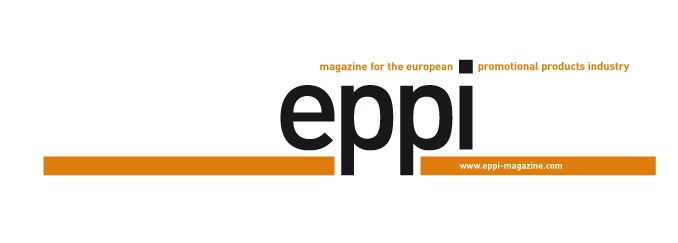In 1998, WA Media, at the time still WA Publishing, introduced eppi magazine, back then and still to this very day the only pan-European magazine for the promotional products industry. Michael Scherer, managing shareholder of WA Media and co-founder of the publication; Project Manager, Till Barth and his predecessor Brit München, today Project Manager of the HAPTICA® live and the Promotional Gift Award, leafed through issues of the last 20 years and talked about Babylonian confusion, almost forgotten product trends and editors on the road.
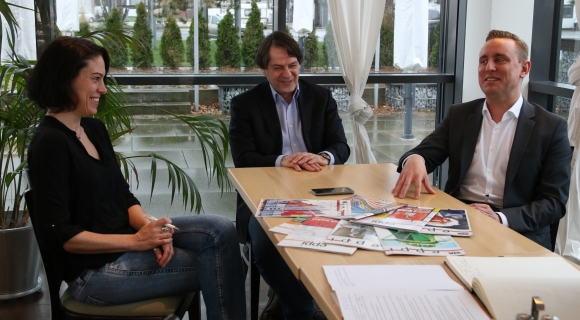
F.t.l.: Brit München, Michael Scherer and Till Barth.
Mr. Scherer, WA Media has been publishing magazines for the promotional products industry since the beginning of the 1980s. What incited you to introduce a new magazine for the entire European market?
Michael Scherer: My former partner, Klaus Stallbaum, and I were the new managing partners of WA Publishing from 1998 onwards. The European promotional products market was on the move in those days, a pioneering mood prevailed: Only a few suppliers had their own international subsidiaries yet – this trend didn’t assert itself until later on. However, many of the big market players already had a strong international alignment, for instance the distributor alliances Ippag, WAGE or IGC. In 1997, the international promotional products show, FIPO, was staged for the first time in Cannes, which understood itself to be the counter project to the PSI Show in Düsseldorf. Then came the foundation of the European umbrella association, EPPSA, which was later renamed EPPA. We wanted to do justice to this increasing Europeanisation of the industry at all levels – with a magazine that examined the European markets in a differentiated manner. The name e.p.p.i. – european promotional products industry – was also the subject matter.
Weren’t there any promotional products magazines in the individual countries then?
Michael Scherer: Yes, there were, among others as the voice of the respective country associations, but not all of them concentrated specifically on haptic advertising and above all they were published in the respective country language, which is still the case today. We wanted to put an end to the “Babylonian confusion” on the promotional products magazine market – with an independent publication, the subscription of which is not tied to a membership and which appears in the business language English. The subject matter – haptic advertising – and the target group – the promotional products trade – were clearly defined back then as they are today.
What were the production conditions of the first issues like?
Michael Scherer: Of course, one can’t possibly compare between then and today. We partly still worked with hand-cut layouts and films. There were still typesetting and lithographic printing workshops, the fax was the state-of-the-art, mobile phones were still quite rare. It wasn’t until later that we first turned semi-digital and then ultimately completely digital. There were five or six employees in 1998, today WA Media is a team of around 30 people including the editorial team, sales, the graphic department and administration, all under one roof.
It was a completely different situation in Europe back then, the first Eastward enlargement of the EU didn’t happen until 2004 for example. Has this had an effect on the circulation?
Michael Scherer: Of course. We began with 16 pages. The circulation of our first issue was approx. 4,500 copies and we hardly had any Eastern European addresses. At the start the strongest distribution was in France with 900 addresses, followed by the Netherlands with around 700. Today, the magazine appears in 37 countries with a total circulation of 10,000 copies, our address pool comprises of 15,000 resellers – not including the German-language countries, for whom we produce an own magazine, Werbeartikel Nachrichten.
How did you succeed in expanding the network?
Michael Scherer: We gradually became wellknown and expanded by travelling a lot, visiting trade shows and establishing contacts to organisers, to internationally aligned companies and groups as well as by constantly updating our data pool. Personal business still plays a major role. The European associations were also an important point of contact. For a while we were even the official magazine of EPPA, with the association’s logo on the cover and own pages inside the magazine. And so, the quality of our contents has constantly grown, because our proximity to the markets grew and we became closer to the market players. And because people passed information on to us, which is something that cannot be taken for granted.
Till Barth: The one depends on the other. If there is no contact there is no information and vice versa. Networking works according to the snowball principle.
Michael Scherer: Thanks to a growing pool of address and clientele we were able to gradually increase the size and the circulation of the magazine. The first issue of the digital counterpart, eppi newsflash, appeared at the beginning of 2002.
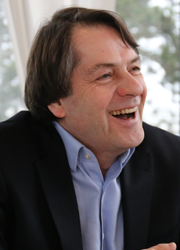
Michael Scherer
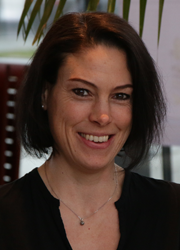
Brit München
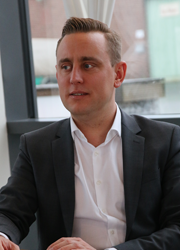
Till Barth
Michael Scherer: There was a lot of talk about the Euro and also controversy, but the currency, although it made many things easier and accelerated the expansion of the individual companies, was not decisive for the pioneering mood. Here for instance the development in Eastern Europe had a major impact because it opened up totally new markets, also for us as a magazine. It led to new structures and information took on a totally different standing than in the established markets, which in some cases already disposed of market publications.
Brit, you took over as Chief Editor in 2005. What was the mood in Europe like at the time?
Brit München: The basic anti-Europe attitude that one often finds today – for instance Brexit etc. – was not very widespread up until the financial crisis. The crisis – which remarkably still wasn’t taken seriously at the PSI Show in 2009 – changed everything. In terms of business, 20052007 were good years. Importers started looking to the East and founded subsidiaries and customising centres there. There were new approaches for trade fairs, an increased exchange between the East and West, the European market became permeable. Of course, this raised questions: How do I address the individual markets? What do I have to bear in mind? What are the structures like?
Michael Scherer: As key contact platforms the trade fairs played a decisive role. The PSI lost its monopoly status and the unifying function of its trade show in Düsseldorf, after installing satellite shows for instance in Warsaw or Paris, which mostly disappeared again fast. Whereby especially the big importers have always wanted a central show in Europe, albeit one that wasn’t tied to a membership – which is where the Pro8 in Amsterdam came into play, which our company organised in 2008 together with the Dutch publisher, Het Portaal Uitgevers. Because the Pro8 addressed European promotional products distributors, we needed a format via which we could inform and invite them.
Brit München: This occurred on the one hand via eppi magazine, which we relaunched at the end of 2007 – including the striking orange, which is still the trademark of the magazine today. On the other hand we cooperated with other communication service providers and in Italy we initiated the spin-off eppi Italia – a deviation from our original concept “one magazine, one language”.
How long did the project “eppi Italia” run for?
Michael Scherer: Until mid-2008, then it was no longer possible to finance the publication. Furthermore, it arose in the scope of the Pro and after the premiere of the Pro we withdrew as organisers. Whether Pro8, eppi Italia or other projects: We have always invested – in some cases at high risk and financial expense – instead of waiting for people to provide us with news. We see market developments that cause us to take strategic decisions and in the ideal case the market follows us then. In this way, eppi magazine ultimately also survived the finance crisis.
What impact did the crisis have?
Michael Scherer: Whole markets collapsed, particularly in Southern Europe. Masses of companies folded. This also meant that advertisement customers who up until then operated on these markets strongly reduced their exports, which we also felt of course. This is why the success story of eppi is not a constant upwards curve either – at least not as far as the revenue is concerned, but definitely in terms of the quality.
Till Barth: When I took over managing the magazine in 2011, the consequences of the financial crises were still clearly noticeable, in some regions the trough hadn’t even been reached yet. We deliberated: What can we do against the economic developments, how can we further raise the profile of eppi?
What happened next?
Till Barth: Since the magazine came out, it has contained country reports, albeit unregularly. Since 2011 we have portrayed a European country per year and that more comprehensively than before: We visit a host of companies, including big market leaders as well as small specialists. On top of this there are also background reports and interviews with market insiders.
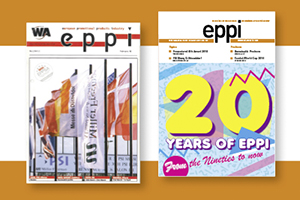
Creative evolution: From issue No. 1 (l) to today’s illustrated covers.
Are the country reports a USP of the eppi?
Till Barth: There is no other promotional products magazine in Europe that provides information on the individual markets in this form. We invest a lot of time and money in research. An investment that however does pay off – mostly not directly, but definitely long-term.
What other further developments have there been more recently?
Till Barth: In the meantime, every issue has a cover story, which focuses on and discusses a current theme in detail. This went hand in hand with a novel design aspect: Instead of showing photos, today the cover is illustrated. This cover illustration has become a kind of trademark. We have continually expanded our range of themes – more best practice examples, more background reports, interviews with users, etc. In spite of all of this, the focus still lies on haptic advertising as always, this won’t change either, just like the target group of eppi will always remain to be the promotional products trade.
What is the cooperation with the associations like today?
Till Barth: The associations are still the voice of the industry and important contact partners. However, the European association landscape is pretty heterogeneous – some of the associations are very agile and pro-active, others concentrate on individual activities, such as a trade show for instance, others only exist in the register of associations.
Michael Scherer: The national associations often still focus on their respective individual interests, which leads to fragmented discussions on a European level.
Till Barth: Furthermore, the PR work of many associations leaves room for improvement – they could take the opportunity to use our magazine as a communication platform more in order to make their issues and work more public within the industry. Association and in particular lobby work only work in conjunction with PR.
Do you think a European umbrella association is necessary?
Till Barth: Yes, if it actually works and it is indeed urgently needed – with a view to the lobby work, but also in terms of inter-European networking and the support of mutual export activities. Indeed there is a lot of international communication within the promotional products industry, but this happens more bilaterally on a corporate level rather than on a superordinate level.
There have to be certain common features for an umbrella association to be expedient. Is this at all true in the case of the European promotional products business?
Till Barth: One only has to walk around a European trade show to see this. Nearly all of the larger suppliers have several subsidiaries in several European countries. There is a lively exchange, many of the market players know each other well.
Brit München: Incidentally, the promotional products industry distinguishes itself from other branches of industry where the group character has replaced the family-like structures. Up until today the promotional products industry largely comprises of small and medium-sized companies.
Till Barth: Of course there are differences regarding the mentalities, market conditions and business practices – even within the individual countries. Companies that want to export successfully, have to be aware of these differences and take them into consideration. How is business conducted? Which terms of payment are standard? Which problems characterise the dayto-day business? Do the market players haggle over the prices or do they spend time grappling with compliance guidelines? Are all steps secured by contracts or are the problems solved pragmatically? Do the business partners dine first or do they come straight to the point? The markets additionally have different structures.
Brit München: The product trends and tastes differ from region to region. However the favourites – like power banks, writing instruments, notebooks or cups – are the same throughout Europe.
Michael Scherer: Ultimately, most of the goods come from China and the product trends are at the most picked up on by the importers, but not developed by them.
On the topic of product trends: How have the trends developed over the 20 years?
Michael Scherer: The technical progress has rendered products like the telephone card obsolete and has made digital gadgets indispensable.
Brit München: Sustainability was and still is a mega trend that is present in all product groups. Promotionwear has progressed in leaps and bounds. A lot has happened in the food sector too.
Till Barth: There have always been short-lived hypes – for instance the fidget spinner last year – however many of the bestsellers are the same as 20 years ago. At the same time, the products have become more target group-specific because smaller volumes can be individualised better, more simply, cheaper and faster and because companies occupy themselves more intensively with how they can reach certain target groups more accurately. I do believe the world of haptic advertising has become more creative overall.
Michael Scherer: There are a lot more possibilities of addressing target groups. Payback & co. are huge systems that promotional products play a major role in and they enable big turnovers to be earned. A further sector that has grown enormously is merchandising.
eppi magazine in short
Target group: European promotional products distributors
Language: English
Range: 37 countries (excl. D/A/CH)
Circulation/Pool of addresses: 10.000/15.000
Frequency Six times per year
Founding year: 1998
Web: www.eppi-magazine.com
Newsletter: eppi newsflash
How has the market itself changed over the 20 years?
Michael Scherer: We could spend hours talking about that. Here are a few keywords to mention just a few of the most significant changes: The classic value chain structure “importer/manufacturer – distributor – end user” has become weaker, the trade, sales and communication channels are more open…
Brit München: …the pan-European market is bigger, more permeable and more professional than at the end of the 1990s…
Till Barth: …sustainability, compliance and product safety have become dominating themes, the
digitalisation has revolutionised the industry and will continue to change it enormously.
Brit München: In spite of all the digitalisation, one will always still have the need to interact with other people and hold products in one’s hand. The biggest fascination about the digitalisation is that people still crave for physical contact, have the desire for face-to-face interaction and haptic aspects.
Do magazines like eppi still have a justified place in the digital era?
Michael Scherer: Not only the statistics of the printing industry make it clear that one certainly can’t talk about specialised magazines dying out – if we narrow it down to our segment. Of course, there are no reliable forecasts for what is going to happen in ten years’ time, but in principle print versions remain to be significant. Catalogues haven’t become obsolete to-date either in spite of the omnipresence of web content and although every company sends out a newsletter today. One tends to fall back on digital formats for brief information, but for more complicated contents one prefers to hold something tangible in one’s hand. There are supposedly also still people, who prefer to read a book rather than use an e-reader (laughs).
Till Barth: In addition to catalogues, corporate publishing is also extremely popular within the industry – corporate magazines, magalogues or similar print formats appear frequently as an enhancement to the online strategy.
We are living in an age today that isn’t exactly shaped by a European pioneering spirit, but instead more by scepticism or the rejection of the European ideal. Where will the European industry be positioned in the future?
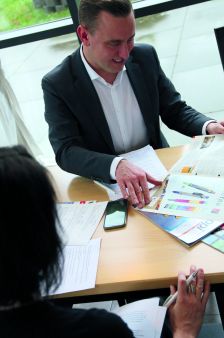 Till Barth: At the moment at least it doesn’t look like “promotional products Europe” is going to become less international. Taking Brexit as an example: Quite a lot of British companies are investing in European-wide sales precisely now. Exports are essential especially for smaller countries, for Belgian, Dutch or Danish suppliers export shares of over 90% are not rare. Regardless of one’s personal opinion about the EU, many companies will continue to try and do business in Europe. One should also clearly differentiate between problems with or criticism of the EU and a general anti-Europa attitude. Just because someone is of the opinion that a hoard of redtape bureaucrats convene in Brussels it doesn’t automatically mean that he wants the borders to be closed off again.
Till Barth: At the moment at least it doesn’t look like “promotional products Europe” is going to become less international. Taking Brexit as an example: Quite a lot of British companies are investing in European-wide sales precisely now. Exports are essential especially for smaller countries, for Belgian, Dutch or Danish suppliers export shares of over 90% are not rare. Regardless of one’s personal opinion about the EU, many companies will continue to try and do business in Europe. One should also clearly differentiate between problems with or criticism of the EU and a general anti-Europa attitude. Just because someone is of the opinion that a hoard of redtape bureaucrats convene in Brussels it doesn’t automatically mean that he wants the borders to be closed off again.
Michael Scherer: Furthermore, I think the mood is starting to change again – I don’t think that scepticism against Europe dominates anymore. In Great Britain for example the latest surveys say that if the referendum was held again today the outcome would be significantly different. One doesn’t know what the populist forces that have become strong in many places, will trigger off next, but overall I believe that the people do have the advantages of the EU in mind a bit too.
So there is still a demand for information and communication platforms for the Euro- pean markets. What distinguishes eppi magazine today from the many national publications?
Till Barth: The alignment of the contents – we have the whole of Europe in our sights, unlike the other magazines. The distribution – with our magazine suppliers reach 10,000 resellers in 37 European countries six times a year. Furthermore, the range of topics, the scope, the depth of the research and reporting, but definitely also the quality demand. Last but not least we are independent. We don’t merely reproduce press releases and we are not tied to an association, interest group or other company.
What are the next projects and themes lined up?
Till Barth: Next on the agenda is the HAPTICA® live in Bonn in March, which WA Media organises and which eppi magazine accompanies of course. We are looking forward to greeting many supplier partners, contacts and friends from all over the globe at the event. Our country report takes us to Denmark and Norway this year, among others we will also dedicate feature articles to the themes digitalisation, auditing, price policies, advertising restrictions and product laws. Further developing the magazine and adapting it to suit the market conditions remains to be a permanent task. However, the core strategy of eppi magazine will not change. Hence, the alignment of the magazine is basically the same as 20 years ago: We are the magazine for the European promotional products industry.
Dr. Mischa Delbrouck spoke with Till Barth, Brit München and Michael Scherer.


